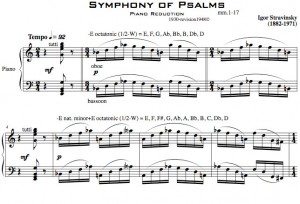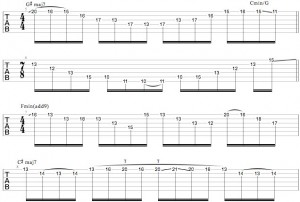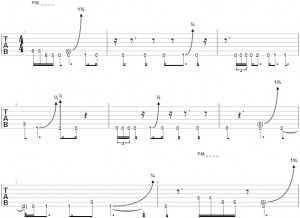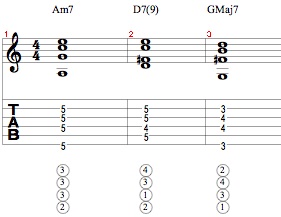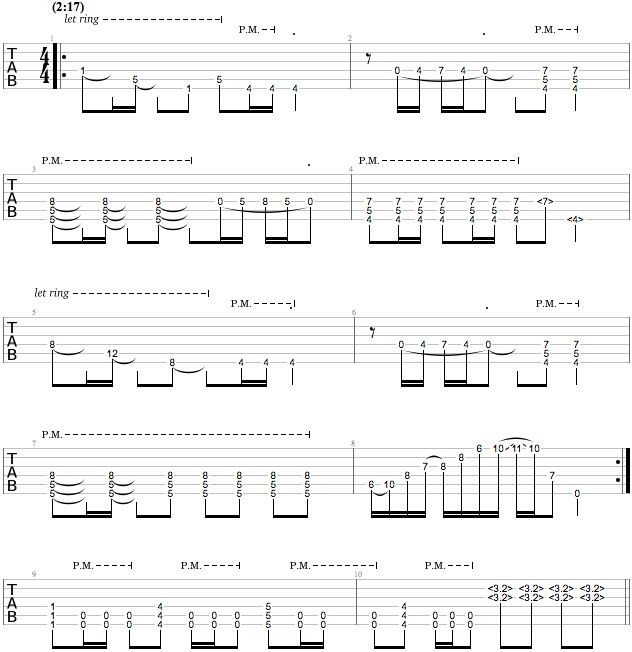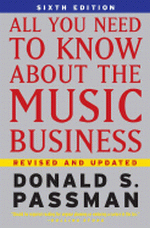I first came about Harmonic Overlapping when studying the formation and inversion of chords, a subject that quickly became an obsession of mine. The idea of Harmonic Overlapping (a term I coined for lack of a better word) hit me when I realized that an Am7 chord (A C E G) was not only an inversion of a C add13 (C E G A), but a fusion of a C major chord and an A minor chord.
Harmonic Overlapping is, in essence, simply that: the superimposition of two or more chords or intervals, diatonic or not (also known as polychord). This is not at all an innovative concept. All chords you already know follow this same basic principle (the stacking of thirds). This column deals with the extrapolation of the system that rules most of western tonal music.
As simple examples, we might consider the following:
Example 1A
Cmaj7 – C E G B – This can be seen through this perspective as a fusion of a C and an Em.
Example 1a
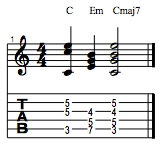
Example 1B
Fmaj7 – F A C E – This could be a F5 (a power chord containing only the root and it’s fifth) over a A5.
Example 1b
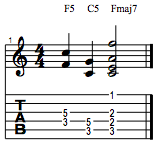
The examples are endless. The following equation better illustrates the idea of combining chords and the many “spellings” that may result:
Example 2
F#m + C#m = F# A C# + C# E G# = F#m7 (9) or A C# E F# G# = Amaj7 (13) or even a C#m add11/13.
Example 2
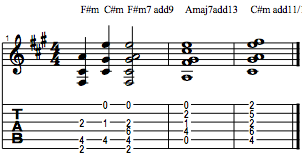
You should notice that this process of overlapping chords doesn’t alter the function of the resulting chord. The chord’s properties (whether it is a I 6/4 chord, a Neapolitan Sixth, an Altered Dominant and so on…) are subject to the musician’s judgment and are not within the scope of this column.
Example 3
Intervals besides the third can also be used in harmonic overlapping. The concept is the same, but instead of using triadic chords, we will now base our structures on other intervals. One of the most common ways to do this is to build chords on fourths. The following example contains some quartal (built with fourths) chords. This is a very humble chord progression to the famous jazz standard “Autumn Leaves”:
Example 3 Autumn Leaves
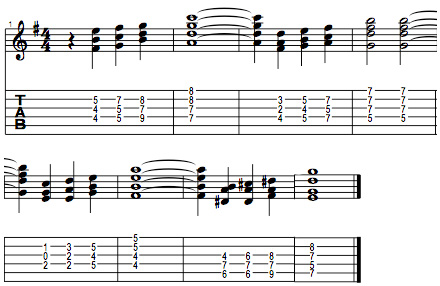
Example 4
Another example is from Allan Holdsworth’s “Humpty Dumpty” from the album Truth In Shredding:
Example 4 Humpty Dumpty

Example 5
Béla Bartok stumbled upon the idea of creating fourth-built chords when studying the folkloric songs of many countries in Eastern Europe and Northern Africa. The genius of Bartok lies in the mixture of the atonal “bridges” between the more tonal main sections of his pieces – a reaction to the post-Romantic era that remains until today a very personal one. This example is taken from the introduction of his Concerto For Orchestra. The first two bars involve the series of fourths we are discussing presently.
Example 5 Bartok

Example 6
The concept can be expanded even further. The following example is a chord progression that involves different intervallic relationships from one chord to another. The first chord is a Dsus2, and is built off of two consecutive fifths. The next two, a Bbmaj7 with an added minor second and a Cm7, are two unrelated major sixths. The third one is a Dm7 in its second inversion voiced as two fourths. Finally, the last chord is a D sus2 with an added fourth.
Example 6
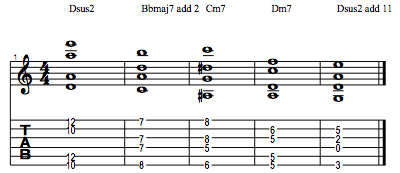
Following are a few examples of this kind of practice by some of the greatest composers of our species:
Example 7
Stravinsky’s Rite Of Spring utilizes, in the section entitled “Dances of The Young Girls,” a Db half diminished over a Eb major chord. The following is one way to voice this chord:
Example 7
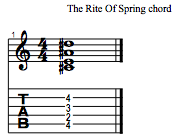
Example 8
This is from Strauss’s Elektra. It is a synthesis of a E major and a C# major chord. This is also found in “Feuilles Mortes” by Claude Debussy:
Example 8

Example 9
Jimi Hendrix puts our theory in action, as well. By superimposing a Bb major chord over a G major triad, we get the Hendrix chord (aka Dom. 7 #9):
Example 9

Example 10
The chords at the end of the introduction of “The Dance Of Maya” by Mahavishnu Orchestra use a combination of sevenths (alternately major and minor) with a major sixth above it. These are very beautiful.
Example 10

There are many other examples in the world of music. It is important that you know that this phenomenon I call Harmonic Overlapping should not be adopted as the only system for creating chords. Many chords cannot be broken down through this system. There are many other ways to create interesting chords, whether it is by pilling up thirds, or adding one or more notes to a chord or by serializing the intervals of a particular pitch class. Hopefully, the idea of Harmonic Overlapping will serve as another tool for you to create interesting chords and enhance your awareness of the background over which you are soloing.



